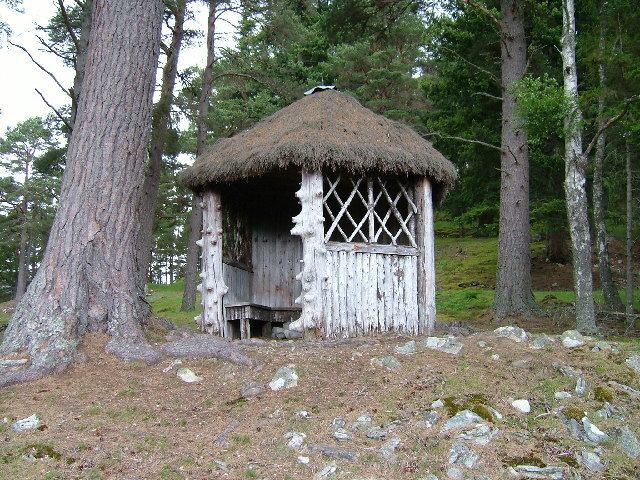 | ||
Fog Houses are a special type of pleasure or summer house popular in Scotland and at one time commonly found on many country estates as a feature in the pleasure gardens. The name 'Fog' derives from the Scots word for the moss that was a major feature of the building, mainly used to line the walls and roof.
Contents
Description
One definition states that 'Fog Houses' were 'Pleasure Houses', small shelters lined with mossy turf. They were often thatched with materials such as heather. Contents typically included a curved bench placed against the walls with other features such as the example at Bonnington Isle that had its table and bench neatly covered with moss, and the one at Ballochmyle in Ayrshire that had the verses of a Robert Burns song hanging from the walls.
Examples of Fog Houses
Ballochmyle lies near Mauchline and Robert Burns' Mossgeil Farm where Robert lived for a time. Whilst walking in the private estate he saw Wilhelmina Alexander, sister of the owner, walking alone and this inspired him to compose a romantic song. Burns wrote to her, enclosing the song, seeking her permission to allow him to publish it. Wilhelmina was 30 years old at the time and no great beauty, so thinking that Robert was teasing her and being aware of his reputation she never replied. The correspondence was however in later life one of her most prized possessions and, as stated, the Ballochmyle Fog House was built in honour of the occasion.
These verses were hung on the walls of the fog house
The Lass o'Ballochmyle
Cuthbertson visited in the 1940s and comments on the winding mossy paths by which the 'heather house' was reached, confirming that it was built on the site where the poet first espied Wilhelmina Alexander. He goes on to mention the rarely visited 'Poet's Seat', a vantage point where Burns would sit and think over his poems and songs. The seat was the branch of an oak that grew horizontally at this point.
The building that overlooked Gaans Holm was octagonal and nine feet wide. It was originally open on three sides however it was later altered to have a doorway and two windows. It had symbols such as hearts and cupid's arrows in addition to the aforementioned verses. The board with the verses was stolen and only recovered twenty years later from an address in Glasgow.
Douglas refers to the fog house as a rustic grotto and states that the two verses were recorded on a tablet.
